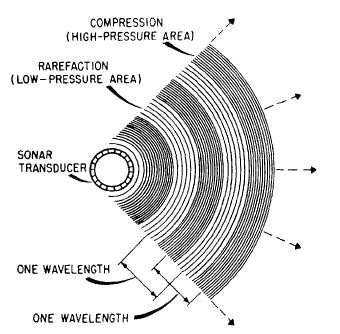CHAPTER 4
ANTISUBMARINE WARFARE
The detection of enemy submarines is one of the
Navy’s major problems today. There are many types
of equipment in use that aid in the detection and
tracking of submarines.
As an aviation electronics
technician, you will need to understand the principles
used in these equipments. Once again, every effort is
made to discuss as many different platforms and
equipments as possible.
SONAR PRINCIPLES
Learning Objective:
Identify factors that
affect the behavior of a sound beam in water.
The word sonar is derived from the initial letters
of SOund, NAvigation, and Ranging. The word sonar
is used to describe equipment that transmits and
receives sound energy propagated through water.
Airborne sonar equipment is commonly called
“dipping sonar,” and is used aboard various
helicopters. Sonobuoys, also a form of sonar, will be
discussed later in this chapter.
The operating principles of sonar are similar to
that of radar, except sound waves are used instead of
radio frequency waves. When the sound wave strikes
an object, some of the energy reflects back to the
source from which it came. Since the speed of the
sound wave and the time it takes to travel out and
back are known, range can be determined. By
knowing the direction from which the sound echo is
reflected, the operator can determine the bearing
information.
The type of sonar equipment that depends
primarily on a transmitted sound wave and the
reception of an echo to determine range and bearing
of a target is known as echo-ranging or active sonar
equipment. Another type of sonar equipment is
referred to as listening or passive sonar. This type of
sonar uses the target as the sound source. Although
most sonar equipment can be used in either mode of
operation, surface ships and aircraft generally use the
active mode, and submarines use the passive mode.
In echo-ranging sonar equipment, the source of
the sound wave is a transducer. The sonar transducer
is a watertight unit that is used to convert electrical
energy into acoustical energy and acoustical energy
back into electrical energy. The transducer acts like a
loudspeaker in an office intercom system, alternately
converting electrical energy into mechanical energy
and mechanical energy into electrical energy. The
transducer acts like an underwater loudspeaker during
transmission and an underwater microphone during
reception. The sound waves produced by a sonar
transducer are represented by the circular lines shown
in figure 4-1. Refer to this figure as you read the
following text.
When the diaphragm of the transducer moves
outward, it moves the water next to the diaphragm.
This produces a high-pressure area or compression in
the water. When the diaphragm of the transducer
moves inward, the water next to the diaphragm moves
inward. Thus, a low-pressure or rarefaction is
produced in the water. As long as the diaphragm is
vibrating, alternate compressions and rarefactions
travel outward from the transducer in the water. The
distance between two successive rarefactions or two
successive compressions is the wavelength of the
Figure 4-1.-Sound waves produced in water by a transducer.
4-1

